Sprouting in your kitchen is easy to do even if you don’t have a knack for growing things. The jars of itty bitty greens is like having a mini garden and once you start, it’s hard to stop though I can’t see how anyone would want to stop sprouting considering the benefits.
I’ve recently started sprouting again because my fiancé loves to put them on everything. They have a very fresh and ever so slight spicy crunch to them; a perfect accompaniment to salads or sandwiches. It’s been something I’ve been doing for him on and off since we met and it’s something I’ll keep doing just because it’s so easy!
What is a Sprout?
Before we get into the how to of sprouting we must first define what a sprout is. A sprout is basically a plant that is right in the process of germinating. Nuts, seeds, grains, and legumes have many locked up nutritional advantages that can be released by sprouting. Once the germination process begins via sprouting, any anti-nutrients like phytic acid are cast aside and you are able to absorb the vital vitamins and minerals.
What Happens During Sprouting
Enzyme Inhibitors and Phytic Acid Become Neutralized
All grains contain some measure of phytic acid and it’s important to soak them in order to neutralize the inhibitors. If you don’t soak your grains the phytic acid will bind with calcium, copper, iron, magnesium, and zinc making it near impossible to absorb them. Phytic acid is also very irritating to the lining of the gut. Unsoaked grains also contain enzyme inhibitors that will not only block enzymes in the grains you’re trying to eat but also enzymes that naturally occur in your gut. Sprouting neutralizes phytic acid and enzyme inhibitors making it very easy for your body to assimilate more nutrients.
Sprouting Increases Digestibility
Besides neutralizing various inhibitors, sprouting also increases the digestibility of nuts, seeds, grains, and legumes because soaking helps convert vegetable protein into simple amino acids. Complex carbohydrates will also break down into simpler glucose molecules. This is why you always want to soak your beans!
Have you ever had digestive issues after eating legumes? Sprouting helps eliminate the complex sugars that are responsible for intestinal gas.
Lastly, since sprouting also gets rid of enzyme inhibitors we are able to take advantage of the beneficial enzymes produced during germination.
All of these factors aid digestion.
Other Advantages of Sprouting
Sprouting also happens to increase certain vitamins like:
• Vitamin C
• Vitamin B2
• Vitamin B5
• Vitamin B6
• Carotene
It’s even said that sprouts played a roll in keeping scurvy at bay. Chinese sailors would bring mung beans on long sea voyages and sprout them aboard the ship. Eating these mung bean sprouts offered the sailors a sufficient and very natural source of Vitamin C.
Sprouts also contain:
• Vitamins A, D, E, and K
• Calcium
• Carbohydrates
• Chlorophyll
• Iron
• Magnesium
• Niacin
• Phosphorus
• Potassium
• Zinc
• All amino acids
• Trace elements
• Up to 35% plant protein
Sprouts are basically a mini multivitamin!
Sprouts Alkalize the Body
As you know, foods can either be acidic or alkalizing to the body and maintaining a balance is what support long lasting health. Nowadays it’s all too easy to eat too many acid forming foods like meats, dairy, grains, and legumes. While these foods in themselves are not necessarily bad for us, it’s important to keep the scales balanced when consuming them. Eating more fresh fruits and vegetables helps to increase alkalinity.
Sprouting also increases alkalinity because in essence, you are eating a very tiny plant.
The Benefits of Sprouting - How to Sprout
Sprouting might seem intimidating but I assure you it’s not! It’s super simple and hardly takes up any time at all. Considering all the benefits that sprouting with impart on your health, it’s totally worth it.
The method is pretty much the same for all nuts, seeds, grains, and legumes it’s just the time it takes to sprout that varies.
Here’s How to Sprout Alfalfa Seeds - My Favorite!
Here’s What You’re Going to Need:
• A large mason jar
• A nut milk bag, Sprouting Screen
, or cheesecloth
• Alfalfa seeds
• Trace Minerals (optional)
Here are a few great books to consider that are all about sprouting:
The Sprouting Book
How to Sprout Raw Food
Sprouts- The Miracle Food
Loving Preparation- How To Sprout Alfalfa Seeds
This is going to be about how to use the mason jar method for sprouting but you can also do the colander method, sprout bag method, or use a sprouter like this or this
.
1. Begin by making sure your large mason jar is clean (this is very important!)
2. Next measure out 2TB of alfalfa seeds and put them in the jar
3. Fill the jar ⅓ of the way up with spring water (do NOT use tap water)
4. Add a few drops of trace minerals if desired to increase nutrient content
5. Secure the nutmilk bag or sprouting screen to the top of the jar and leave it out on the kitchen counter overnight
6. The next morning you will notice very tiny sprouts beginning to emerge!
7. What you’ll want to do now is pour out the night’s soaking water (just keep the nut milk bag/sprouting screen secure on the top of the jar)
8. Fill the jar again with fresh spring water and swirl things around a bit
9. Invert the jar in your dish rack to allow the water to drain
10. Before bed, rinse the sprouts again and invert the jar once more in the dish rack
11. Be sure to rinse the sprouts morning and night for the next 5-6 days
12. Once your sprouts have grown it’s time to de-hull them
13. To do this, pour the sprouts into a large bowl and fill it with water (filtered if possible)
14. Use your hands to shake the sprouts around in the water until the hulls come loose (some will float but a lot of them will sink)
15. Carefully rinse away as many hulls as you can as they can cause mold if there are too many of them
16. After you’re finished put the sprouts in a container in the fridge for use over the week
You can enjoy alfalfa sprouts in wraps, salads, and sandwiches! You can even throw them in your juicer or in a smoothie. The benefits of sprouting are endless!
***Be sure that you never eat contaminated sprouts or sprouts that are slimy or moldy.
[yumprint-recipe id='9']Here is another method to grow alfalfa sprouts without using a jar:


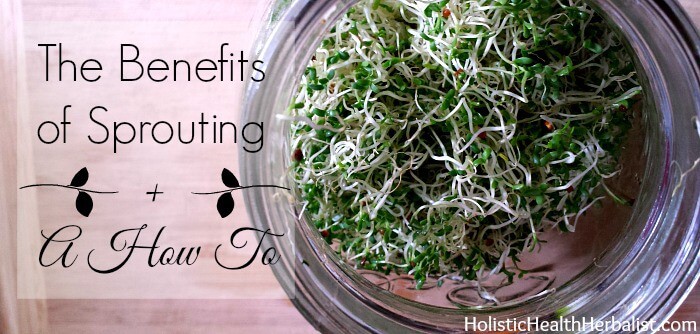

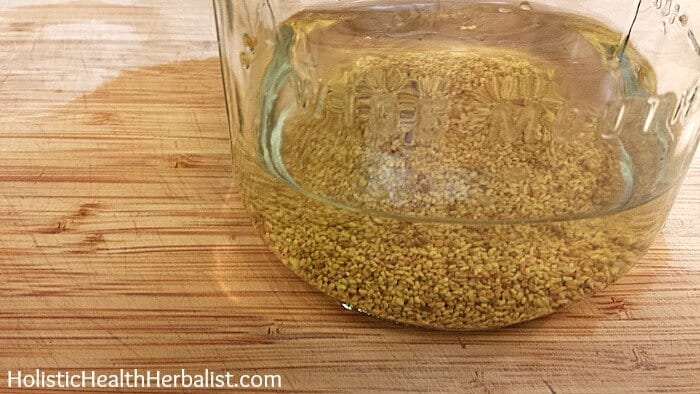
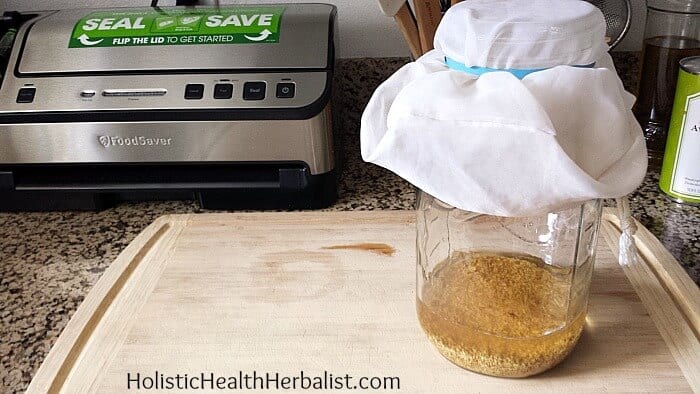



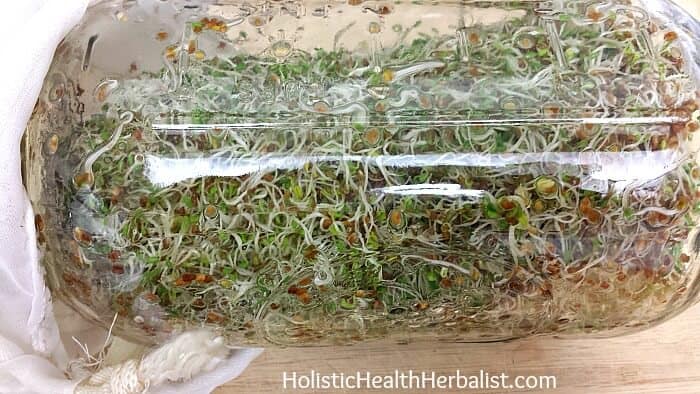


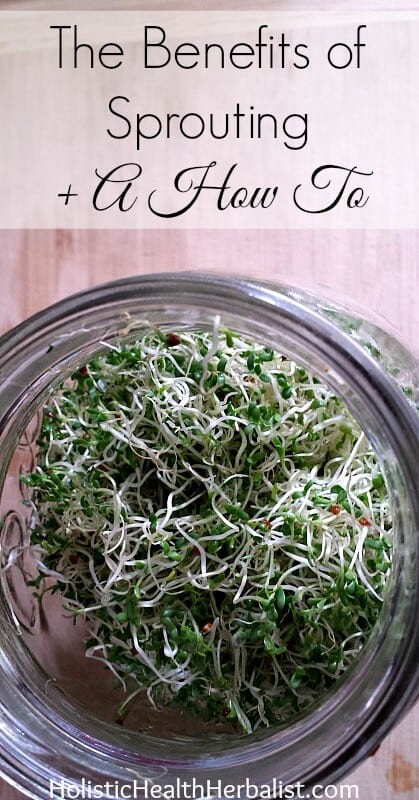




linda spiker says
I love sprouts! I need to add more of them into my recipes!
Tash says
They add such a fresh flavor to everything you put them on. My fiance eats them right out of the jar!
Emily @ Recipes to Nourish says
I didn't know about all of the health benefits! What a cool idea. I love alfalfa sprouts too!
Ariana {And Here We Are...} says
Sprouting is totally on my to-do list right now! I need to order some broccoli seeds. Thanks for this great post!
Tash says
They're so simple! You might find yourself trying all kinds of varieties once you inevitably get hooked!
Eileen says
Thanks so sharing this great information. I so wish this had been available when I first tried sprouting--would have made it much easier!
Tash says
They're so easy! I hope you give it another go 🙂
Renee Kohley says
So simple and look at all those amazing health benefits pulled out just from sprouting! So great!